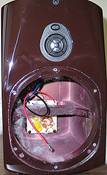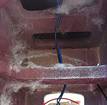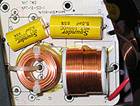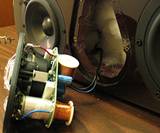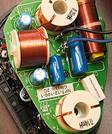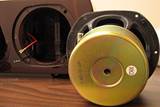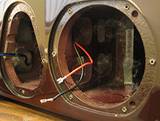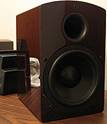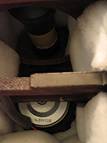NHT Classic 2 Speaker System Review
- Product Name: Classic 2
- Manufacturer: NHT
- Performance Rating:




- Value Rating:




- Review Date: December 07, 2006 12:10
- MSRP: $ 1,700 - $2,200
Classic Two:
Two-way bookshelf. 6.5" polypropylene cone woofer, 1" aluminum dome tweeter. 12.7 lbs
Absolute Zero: Two-way bookshelf. 5.25" polypropylene cone woofer, 1" aluminum dome tweeter. 8 lbs.
Two C: Three-way center channel. 2 x 5.25" aluminum cone woofers. 2" aluminum dome mid-range and ¾" tweeter pod.
Ten: Vented 150W Powered Subwoofer. 10" long throw aluminum cone woofer. 41 lbs.
Classic Two:
Freq Response 51 Hz - 20kHz, Crossover Freq 3 kHz, Crossover Slopes 18dB HP, 18dB LP, Sensitivity 86dB (2.83v@1m), Impedance 6 Ohms nominal
Absolute Zero: Freq Response 71 Hz-20kHz, Crossover Freq 3kHz, Crossover Slopes 18dB LP, 18dB HP, Sensitivity 86dB (2.83v@1m), Impedance 6 ohms nominal
Two C: Freq Response 78Hz - 20 kHz, Crossover Freq 800 Hz, 3.2kHz, Crossover Slopes 12dB LP, 12dB HP, 18dB LP, 18dB HP, Sensitivity 87dB, Impedance 8 ohms nominal
Classic Ten Sub:
Freq Response 31 Hz - 180 Hz +/- 3dB, Crossover Freq 40Hz - 140Hz adjustable low pass, Crossover Slopes 12dB/octave high pass, 12dB/octave low pass, Phase 0/180 degrees switch
Pros
- NHT hits a home run in build quality with arguably the nicest designed, most sturdy cabinets in the business.
- Two C is a true three way center channel speaker, rare in this price range.
- Improved acoustic design over Super Audio series provides more detailed mid/highs and greater dispersion.
Cons
- So many different drivers mean speakers in this system may not be the perfect match for each other.
- NHT Ten Subwoofer requires a smaller room to provide LFE at impact volume levels.
- Classic Two 5.1 system suffers from Jan Brady syndrome. In between two more practical 5.1 systems in the Classic Zero and Classic Three.
NHT Classic Two Setup
They say perfect objectivity is an unrealistic goal, though fairness is not. I must admit I’m a little biased when it comes to NHT speakers, since they were my first real hi-fi speakers. I almost bought a used pair of NHT Super-Twos, but their new Super Audio line had just been released, so I bought the ST-4s instead. NHT has implemented some clever ideas, bringing high-end sound to the budget-minded people like me. Super Audio is where NHT brought its aluminum-dome tweeters and a separate enclosure design to its ST-4. These are ideas that would be improved upon in the Classic series.
 The Classic Two
is a complete 5.1 bookshelf speaker system. It consists of two Classic Two
bookshelf speakers, two Absolute Zero bookshelf speakers, a center speaker and
a subwoofer. The Two C is this system’s center channel speaker, and at first
glance, it appears to be a real gem for this system. It’s a three-way center
speaker, set up with a superior configuration than the Super Audio’s center
channel speakers. The subwoofer in this system is NHT’s Ten, a powered sub with
a 10" driver.
The Classic Two
is a complete 5.1 bookshelf speaker system. It consists of two Classic Two
bookshelf speakers, two Absolute Zero bookshelf speakers, a center speaker and
a subwoofer. The Two C is this system’s center channel speaker, and at first
glance, it appears to be a real gem for this system. It’s a three-way center
speaker, set up with a superior configuration than the Super Audio’s center
channel speakers. The subwoofer in this system is NHT’s Ten, a powered sub with
a 10" driver.
Two: Two-way bookshelf. 6.5" polypropylene cone woofer, 1" aluminum dome tweeter. 12.7 lbs
-
Absolute Zero: Two-way bookshelf. 5.25" polypropylene cone woofer, 1" aluminum dome tweeter. 8 lbs.
-
Ten: Vented 150W Powered Subwoofer. 10" long throw aluminum cone woofer. 41 lbs.
-
Two C: Three-way center channel. 2 x 5.25" aluminum cone woofers. 2" aluminum dome mid-range and ¾" tweeter pod.
The Classic Two is NHT’s step-up system from the Classic Zero, another almost identical 5.1 speaker system. The only difference between the Classic Two and Classic Zero is the inclusion of the Two bookshelf speakers for the front. The speakers I received came in the new Special Dark color, reminiscent of a black cherry wood, but they’ve got a smooth, glossy finish. Since I had only seen the sample color square of Special Dark on NHT’s website, I wouldn’t have picked this color for myself. However, once I got a look at all the speakers together, I found that the Special Dark did have a charm of its own. The smooth lines of all the Classic speakers harkens back to another era in electronics, when even radios had a distinctly art deco look to them. But the contours in the upper enclosures aren’t simply for style. Apparently, it tightens the space inside the acoustic suspension enclosure around the tweeter, which provides a more solid cabinet design. According to NHT, this will increase the resolution from their aluminum dome tweeters.
Aluminum Tweeter / Mid-range Pod
New to NHT’s Classic line is the aluminum dome mid-range/tweeter pod. This system consists of a 2" aluminum dome mid-range and a ¾" tweeter. The special assembly is designed to provide enhanced dispersion and resolution, and is found in the Two C center channel speaker. The Three C, the Three, and the Four tower speaker from the Classic line also use NHT’s special aluminum dome tweeter/mid-range pod. NHT’s use of aluminum in the speaker is a clever way of bringing the high-end performance of a very rigid but lightweight material into the drivers. The 1" aluminum driver has been used by NHT in its previous Super series, and that same driver still exists in the Two and Absolute Zero. For the aluminum tweeter/mid-range pod found in the Two C center, NHT has incorporated a scaled down version of their 1" tweeter which is a ¾” size in this system.
Pricier, high-end speakers by the likes of B&W, JM Labs and others use costly minerals like diamond and beryllium to achieve a more ideal driver response. Aluminum, if implemented properly, can share many of the performance virtues of the more exotic materials at a fraction of the cost. Lately, we’ve all probably seen too many speakers using aluminum drivers or even knock-offs of aluminum drivers just for appearance’s sake, but they fail miserably to achieve the audio benefits you want. One of the most significant changes to the Classic line - which isn’t mentioned on any of their spec sheets - is the upgraded cabinets: they’re now double-braced with a stiffer structure, to help prevent panel acoustic output and improve dispersion.
Setup
 Minimal assembly was required to place tracks on
the bottom of the bookshelf speakers. Both the Absolute Zero and Two had
rounded bottoms, which would be fine for hanging on the wall but wouldn’t sit
right on a stand. Included with the tracks are rubber feet and screws to fasten
them on.
Minimal assembly was required to place tracks on
the bottom of the bookshelf speakers. Both the Absolute Zero and Two had
rounded bottoms, which would be fine for hanging on the wall but wouldn’t sit
right on a stand. Included with the tracks are rubber feet and screws to fasten
them on.
At 20’ x 31’ my Home Theater room is too large for a small bookshelf speaker system and a solo 10” sub. I set them up anyway, to get an idea of the sound, and was obviously completely under whelmed. It’s not surprising the details and bass were lost inside this room, with its carpeting and big couch. Even with the sub corner loaded, it couldn’t build up enough momentum to produce the rumble required of Home Theater. Also, in this room, the Twos didn’t have the dispersion or dynamic range to produce any compelling soundstage. However, the center performed admirably, as voices in the soundtrack were clear - a testament to the design of the aluminum dome tweeter / midrange.
I had a chance to break in the Absolute Zeros and Twos separately, using them as stereo-only speakers connected to a system in a smaller room in the basement. The gym in the basement is where I listen to loud music intended to inspire me to move faster and push just a little more weight. The bass output in both these tiny speakers blew me away considering their size (however the resonance of the low ceiling probably contributed favorably to their total output). I was also surprised by the weight of both pairs, after several times hefting them onto a shelf near the ceiling. Going back and forth (when I’m already tired) was a workout in itself and gave me an opportunity to hear the speakers in a casual listening environment.
The biggest surprise was the Absolute Zero - for such a small speaker, the frequency response was amazing and the dynamic range of the lower frequencies caught me off guard. There was a point during some of the hard rock tunes where I had to turn the volume down, because the bass was hurting my head. I certainly didn’t expect this from the Absolute Zero. The more I listened to it in comparison to the Twos as two channel-only speakers; I started to detect a slightly different character from the Absolute Zero. It seemed a little more articulate in the upper midrange than the two. The cost of using a smaller woofer in the AZ is of course bass response, but somehow I didn’t even notice the loss while listening. If I had to fill a small to medium-sized room with two channel stereo sound, I wouldn’t hesitate to recommend the Absolute Zero. I could easily see it being used as the front speaker in a 5.1 system.
 After this test, I took
the whole 5.1 system out of the large Home Theater room and reassembled it in a
considerably smaller bedroom, measuring only about 10’x15’. I put the sub in
the front corner of the room and set up the Twos up front on stands. The
Absolute Zeros sat on nightstands on either side of the bed.
After this test, I took
the whole 5.1 system out of the large Home Theater room and reassembled it in a
considerably smaller bedroom, measuring only about 10’x15’. I put the sub in
the front corner of the room and set up the Twos up front on stands. The
Absolute Zeros sat on nightstands on either side of the bed.
Testing Home Theater in a bedroom was certainly an exercise in decadence. At first I didn’t trust the Absolute Zero speakers being so close to me - they were only about three feet away from my ears and less than a foot from the wall. But after calibration and toying with positioning, I was amazed at the imaging of rear channel. When the rear channel speakers were tested together to create a phantom center rear, it sounded like the test tone was coming from a sixth speaker inside my head.
NHT Classic Two Build Quality and Listening Tests
It was time to crack open the NHT speakers and take a look inside. When opening the Two speakers, I noted how air-tight the seal was. After removing the screws I practically had to pry the woofer off to get inside. These speakers are well put together, and taking them apart gives you an appreciation for the fine quality of their build.
A looking inside of the Two’s revealed the solid wood interior had costly baffle bracing as you can see here. The braces are quite solid, made as thick as the walls of the cabinet.
These are the crossover in the Two and speaker cable bindings. I’m no engineer, but I recognize the substantial components used. Air core inductors and polypropylene capacitors are all good ingredients for excellent crossover design. They appeared to employ 2nd order parallel filter networks which are great for better power handling and better driver integration. The first image shows the binding posts, which had to be removed to gain access to the crossovers. Fat metal posts with well-fit metal screws, that even the thickest fingers will have no trouble gripping.
The Crossover on the aluminum dome tweeter / midrange “pod” of the Two C center channel. Again quality components were employed throughout the entire crossover network.
A look inside the Two C center channel speaker reveals the same significant structure as the Two speaker. The wood is solid, with no visible seams and full bracings between driver assemblies.
The Ten’s 150 Watt power amp is sealed in plastic, mounted on the back of the sub with no less than 12 screws. Even the weight of the amp didn’t cause it fall out when it was unfastened. The double-braced interior of the sub shows the NHT Classic line has uniform attention to a heavy duty build quality. These rigid speaker cabinets will reduce vibrations for a better acoustic experience.
NHT Classic Two: Listening Tests
Once calibration was over it was time to have some fun with this system - I still had yet to hear the speaker system in a room where it stood a chance of showing off some of its capabilities. Having always had a weakness for horror, and it being Halloween, I decided to test some of my favorite scary soundtracks. The bedroom TV is a spare 32” standard definition TV, having long since been replaced in the main room with HD. The old TV is rarely used anymore but its time had finally come.
First up - Blood:
The Last Vampire.  This is one of the best little bits of Manga
(lasting only about 45 minutes), with a fantastic 5.1 soundtrack. It takes
place in a US Air Force base in Japan
just prior to the Vietnam War. It seems the base was infiltrated by these
shape-shifting, blood-sucking bat monsters that turn into anemic American
school girls, and the only way they can be stopped is by a native Japanese
school girl who also happens to be a sword wielding tough gal and a vampire to
boot.
This is one of the best little bits of Manga
(lasting only about 45 minutes), with a fantastic 5.1 soundtrack. It takes
place in a US Air Force base in Japan
just prior to the Vietnam War. It seems the base was infiltrated by these
shape-shifting, blood-sucking bat monsters that turn into anemic American
school girls, and the only way they can be stopped is by a native Japanese
school girl who also happens to be a sword wielding tough gal and a vampire to
boot.
My gross oversimplification notwithstanding, it’s actually a pretty good story, featuring characters that have distinct and complex personalities and plenty of shocking sounds. But the real reason to watch this spooky exercise in gore - besides the mixture of drawn and computer animation - is the 5.1 surround mix, which produces both subdued chills and sudden frights that’ll make you jump out of your skin.
 In the school Halloween Party scene, you’re treated to
Benny Goodman-style big band swing, which really stands out on a good quality
system. Details in the sounds of instruments being tuned up just before a
number were satisfying on their own; but then, as the band kicks in, the
soundtrack opens up with some dazzling soundstage and very musical sonic
imaging. You can actually place different instrument sounds coming from
different areas in the room. The Ten sub gave this system a satisfying,
“complete” sound in my very small room.
In the school Halloween Party scene, you’re treated to
Benny Goodman-style big band swing, which really stands out on a good quality
system. Details in the sounds of instruments being tuned up just before a
number were satisfying on their own; but then, as the band kicks in, the
soundtrack opens up with some dazzling soundstage and very musical sonic
imaging. You can actually place different instrument sounds coming from
different areas in the room. The Ten sub gave this system a satisfying,
“complete” sound in my very small room.
The opening scene in the movie takes place in a subway train, where the directional effects of the train whizzing by are enhanced in both the rear and front speakers. They can handle the loud, booming sounds of scenes occurring outside the train, and also the subtle rumbles of the action taking place inside. At the times in the film when it was necessary to really throw peaks into the room, the subwoofer seemed easily up to the task.
Frank Zappa Halloween
DVD Audio: This is a pretty straightforward  rock album, and is
one of my favorite tests of mid, highs and mid-bass, as well as resolution,
detail and soundstage. Frank Zappa did a series of concerts in the late 70’s
with a band consisting of some of the most talented performers of the day. It
was the intention that the original recordings would be made into a
quadraphonic release, but that never happened. However, it was easy for Dweezil
Zappa (Frank’s son in case you’re not up on your Zappa genealogy) to re-master
them for DVD Audio.
rock album, and is
one of my favorite tests of mid, highs and mid-bass, as well as resolution,
detail and soundstage. Frank Zappa did a series of concerts in the late 70’s
with a band consisting of some of the most talented performers of the day. It
was the intention that the original recordings would be made into a
quadraphonic release, but that never happened. However, it was easy for Dweezil
Zappa (Frank’s son in case you’re not up on your Zappa genealogy) to re-master
them for DVD Audio.
The results are stunning. The midrange detail and resolution offered by this speaker system rivaled (and probably exceeded) my own main system, which has the NHT ST-4s up front. A little more subtlety was apparent in Frank’s Black Napkins / Deathless Horsie guitar work, and details lost on the ST-4s in the large room presented themselves with this setup in the closer quarters. But could it simply be the effect of being in a tighter environment? Smaller speakers playing closer to my ears may have contributed to perceived gains in upper frequency details.
My ST-4 speakers have played the same tracks many times and never failed to impress. But they are very smooth sounding speakers with laid back sound. The Two / Absolute Zero combination put the details a little more forward and of course lost some of the mid-bass. As expected with the smaller drivers, mid-bass was a little thin. I experimented with turning up the subwoofer’s crossover to 100Hz and 140Hz (from its usual 80Hz setting) to try and compensate for lack of mid-bass. In some applications, like two channel music, I speculated I might get a bit more mid-bass from the sub. The speakers were set to “small” in the receiver, so anything 80Hz or lower was being diverted to the sub. I also tried to compensate for the system’s mid-bass by dialing up the crossover, but it’s just couldn’t produce the same effect as larger speakers in a slightly bigger room.
I was impressed with the mid and high frequency detail of the Two / Absolute Zero combo; it rivaled and even exceeded at times the detail and imaging of my own big room system. The Ten offers tight bass response, perfect for music. For a bass head like me - I feel movie soundtracks would benefit from a Twelve providing a little extra oomph in the LFE. In my 10’ x 15’ listening room, the Ten was potent enough; but if the room got up to 20’ x 25’ with an eight foot ceiling and a couch, I would recommend a subwoofer upgrade.
 The Ten is rated to go down to only 31 Hz though this is a
reasonable design compromise since the Ten is only designed for smaller rooms. Many
sub manufacturers feel they must reach 20Hz, but NHT’s philosophy is: It’s not how low you go but how well you go low.
A budget sub that can hit 20Hz is liable to rob the higher bass frequencies of
some dynamic range or linearity. It’s difficult to design a sub that keeps
constant sound pressure levels as frequency drops. Human ear sensitivity
diminishes at decreased frequencies, so a 20Hz signal has to be louder than a
40Hz to be perceived as loudly. The cost of a sub dropping to 20Hz is either
its dynamic range or a tremendous amount of amplification, cone area, excursion
and/or all of the above. The Ten was clearly designed for a small room.
In larger rooms, I highly recommend two
Ten subwoofers for added headroom, better modal control and a wider
bass consistent listening area. Better yet, bass heads should upgrade to
a Twelve or two for the ultimate bass impact.
The Ten is rated to go down to only 31 Hz though this is a
reasonable design compromise since the Ten is only designed for smaller rooms. Many
sub manufacturers feel they must reach 20Hz, but NHT’s philosophy is: It’s not how low you go but how well you go low.
A budget sub that can hit 20Hz is liable to rob the higher bass frequencies of
some dynamic range or linearity. It’s difficult to design a sub that keeps
constant sound pressure levels as frequency drops. Human ear sensitivity
diminishes at decreased frequencies, so a 20Hz signal has to be louder than a
40Hz to be perceived as loudly. The cost of a sub dropping to 20Hz is either
its dynamic range or a tremendous amount of amplification, cone area, excursion
and/or all of the above. The Ten was clearly designed for a small room.
In larger rooms, I highly recommend two
Ten subwoofers for added headroom, better modal control and a wider
bass consistent listening area. Better yet, bass heads should upgrade to
a Twelve or two for the ultimate bass impact.
Next stop in my listening tour of the NHT Classic Two 5.1 speaker system was a movie near to my heart on Halloween: Corpse Bride.
 At this point I had the volume on the sub up to ¾, which
I would never do on my main system. The scene where Victor Van Dort (Johnny
Depp) first unknowingly puts the ring on the Corpse Bride is a good test of any
subwoofer rumble. I must say the scene was not a disappointment. The only
recent thing I have to compare to the rumble made as the corpse bride rises
from her grave is how it sounds in a 20x30’ room with two 12” subs. It’s not a
comparison that works favorably for the Ten, but all alone in a smaller room
the Ten exceeded my expectations. When the soundtrack required LFE rumble, the
Ten delivered adequately. However, I am not confident it would hold up in a
much larger room, considering the volume was already turned up.
At this point I had the volume on the sub up to ¾, which
I would never do on my main system. The scene where Victor Van Dort (Johnny
Depp) first unknowingly puts the ring on the Corpse Bride is a good test of any
subwoofer rumble. I must say the scene was not a disappointment. The only
recent thing I have to compare to the rumble made as the corpse bride rises
from her grave is how it sounds in a 20x30’ room with two 12” subs. It’s not a
comparison that works favorably for the Ten, but all alone in a smaller room
the Ten exceeded my expectations. When the soundtrack required LFE rumble, the
Ten delivered adequately. However, I am not confident it would hold up in a
much larger room, considering the volume was already turned up.
The scene that follows after the meeting with the Corpse Bride is the skeletal jazz band musical number in the underground lair of undead. The performance was amazing – every playful detail was brought out, and was masterfully executed with slightly more forward highs than I’m used to on the ST-4s.
 I cherry-picked scenes from other haunting films, like
the THX version of Suspiria
- a favorite this time of year, that makes as good a test of video as it does
audio. Sadly it’s only half as good at 480i. The sounds of Goblin’s horror art
rock were as detailed as ever, but confirmed that the system could use a bit
more mid-bass. Another selection, Iron Maiden’s
Death on the Road
concert, was recorded at Westfalenhalle Arena in Dortmund,
Germany. One note on this
choice is it has horrible video production. The video flashes from one scene to
another in quick succession like a strobe light. It’s as if they’re trying to
induce an epileptic fit. But, as a saving grace, it sounded excellent with only
a few small compromises. I had to turn up the sub a little louder than I was
comfortable with to add some boom, and I also again found a slight lack in
mid-bass.
I cherry-picked scenes from other haunting films, like
the THX version of Suspiria
- a favorite this time of year, that makes as good a test of video as it does
audio. Sadly it’s only half as good at 480i. The sounds of Goblin’s horror art
rock were as detailed as ever, but confirmed that the system could use a bit
more mid-bass. Another selection, Iron Maiden’s
Death on the Road
concert, was recorded at Westfalenhalle Arena in Dortmund,
Germany. One note on this
choice is it has horrible video production. The video flashes from one scene to
another in quick succession like a strobe light. It’s as if they’re trying to
induce an epileptic fit. But, as a saving grace, it sounded excellent with only
a few small compromises. I had to turn up the sub a little louder than I was
comfortable with to add some boom, and I also again found a slight lack in
mid-bass.
For a final test of the speaker’s sound, I picked out something I knew would use plenty of deep bass. It was time for the metal / techno sounds of Linkin Park, and the DVD Audio Reanimation (a collection of remixes that uses bass and drum machines liberally).
 Linkin Park’s remix of Points of Authority, called Pts.Of. Athrty, features a video that
looks like a scene from a video game. It’s also got enough bass to really test
the subwoofer in a room like mine. Some describe a subwoofer as “musical” or
fast, in that it can respond to changes in bass tempo without getting boomy.
This is the Ten’s forte with its very quick bass response. In my smallish room
at 10’x15’, it was loud enough at ¾ volume to fulfill my guilty pleasure of a
little too much bass.
Linkin Park’s remix of Points of Authority, called Pts.Of. Athrty, features a video that
looks like a scene from a video game. It’s also got enough bass to really test
the subwoofer in a room like mine. Some describe a subwoofer as “musical” or
fast, in that it can respond to changes in bass tempo without getting boomy.
This is the Ten’s forte with its very quick bass response. In my smallish room
at 10’x15’, it was loud enough at ¾ volume to fulfill my guilty pleasure of a
little too much bass.
NHT Classic Two Considerations and Conclusion
After a bit of research into the NHTs Classic line, I believe the Classic Two suffers from Jan Brady syndrome – “Marsh, Marsha, Marsha”. This is because the Two fits between two systems that are likely to be more popular. The Classic Zero is probably one of the best options for a budget bookshelf system and a smaller room. A system comprised of Absolute Zero front and surrounds would make a very nice match for the Ten subwoofer. The Classic Three may be one of the finest bookshelf 5.1 speaker systems, period. The Classic Two may have difficulty finding the perfect application with only a pair of Two’s up front and a pair of Absolute Zero speakers for surrounds. This system can be found for an excellent retail price of about $1700.
NHT gives you the freedom to mix and match. The speaker systems found on NHT’s website like “Classic Two” and “Classic Zero” are only suggested systems, these are not pre-packaged systems.. Assembling speakers from NHT’s Classic line to fit your individual needs is a real treat and there might be some better ways to match the speakers.
When putting together a 5.1 speaker system you’re not just buying speakers. You’re answering a problem, like a math equation, with the best possible answer. In this case, the problem is the room you must fill with sound. The solution most manufacturers want to sell you is based purely on meeting a certain price goal. Shoppers often get caught up following manufacturers’ and retailers’ own incremental cost-centric solutions - a fact made evident when you see the aisle of A/V gear at Best Buy and how it’s lined up by cost. This marketing style leads people to believe that on one end (generally the lower-priced end) lies the best solution, and on the other, the least desirable. This forgets each product’s unique qualities. The result is consumers end up forcing standardized systems into their living rooms when they should really be demanding that their specific needs be met. That can’t always come from a pre-labeled rating. With NHT’s Classic line this Californian manufacturer hasn’t forgotten that the key to buying your personal 5.1 speaker system is to remain focused on the best possible solution to the “problem”. And that solution doesn’t necessarily fit into most manufacturer’s ideas of “good”, “better” or “best”. NHT provides suggested matches giving consumers the ability add speakers to assemble a 6.1, 7.1 or add an extra sub.
One weakness of the Classic Two as a complete system is that no two speakers use any of the same woofers. This can be easily circumvented by employing substitutions for the best driver match possible.
It would seem that this system was assembled to meet a price point above the Classic Zero, but below the Three. You can’t blame NHT for the demands of the market; they’re just playing the game by putting out the Classic Two. If you have the choice, you might want to add a couple of tweaks and go ‘outside the box’ so to speak to create the best solution to your “problem”.
Recommendations
Differences between the Two and Absolute Zero were noticeable, but not in the way one might expect. The Two wasn’t clearly the Absolute Zero’s superior. In fact, it was my observation that in a smaller room either would make a fine cornerstone for a 5.1 system. And, by supposedly ‘downgrading’ to Absolute Zero, you could actually save about $200 on the price of front speakers, without noticeably compromising quality. If cost isn’t a factor you could go with four Two’s and upgrade the sub to the Twelve which is a better match for the Twos.
The Two C is a suitable member of this system if placement for the center speaker is inside a shelf or on top of a projection TV over the audience, it’s probably best to keep it. The Center is tuned a little differently than a regular speaker because it’s designed to compensate for boundary reinforcements caused by shelves, close walls or sitting on top of a big TV. But, if you have the ability to place the speaker on a stand, you might want to consider simply using another Absolute Zero (or Two if you went that route) as your center. This substitution actually saves you about $300.
If you take both these paths, you’ll end up with five speakers that are completely matched and a savings of about $500 - but hold on you’re going to need some of that.
The next thing you’ll have to do is upgrade that Ten sub to a Twelve (or buy a second Ten). Both solutions will accomplish the same goal of providing the low end you’ll be missing out on with all those Absolute Zeros. The Twelve costs about $300 more than the Ten, but it’ll be worth every penny.
Conclusion
Overall if I was looking for a 5.1 speaker system in the budget of almost $2,000, would I buy this system?
Two grand on this speaker system isn’t cheap, despite its being classified in the low cost category. But, for a high quality set of bookshelf speakers, you would be hard pressed to do any better. Looking around at competitors in this price point brings up systems like B&W 602 or MT-20. Bose priced its Lifestyle 28 system at $2,000 for speakers that are a fraction of the size of the Classic Two with less than a fraction of the sound quality. There is no doubt that for a smaller room around 15’x20’ the Classic Two system will really shine. For this price it would be difficult to find comparable build quality or speakers with rigid, sealed enclosures for tightly controlled sound.
With its Classic line, NHT has further pushed the envelope to bring high end performance and affordability. If I had a larger room to fill (20’x20’ or greater) I would be tempted to save the money for the Three system - I haven’t heard it yet, but by all accounts it looks like NHT has produced something very special in the Three. The Absolute Zero / Two / Ten / Two C combination isn’t the best matched speaker system I’ve seen, and I’d be tempted to tweak it. But, I was impressed enough with each speaker in this system to recommend it in any combination.
The silver lining to the Classic Two driver mismatch is if you listen to a lot of CDs and other two channel music sources. You would definitely appreciate the extra push given to the mid-bass having a pair of Twos up front as opposed to the system comprised only of Absolute Zeros. Once my ears adjusted to CD music using only on the Twos I actually caught myself putting my hand on the Ten sub just to ensure it wasn’t being used. I also found the 2.1 music experience very satisfying. The low end wasn’t muddied at all by incorporating the periodic murmur of the Ten subwoofer. NHT’s attention to the musical qualities of their speakers is evident in the details.
The NHT brand should generally be considered by anyone who wants a home theater system that easily makes the transition to hi fidelity music. The Classic Two system should be auditioned if you’re looking to NHT and have a medium to small sized room. Other more sub-heavy 5.1 speaker systems might shake the walls a little more than the Ten from this system is capable of. But, articulate midrange and detailed highs are this system’s forte. If you like to hear every whisper in a film’s soundtrack, subtleties like birds in the background or wind rustling through trees, then this is the definitely a speaker system to get excited about.
NHT
6400 Goodyear
Road
Benicia, California 94510
U.S.A.
The Score Card
The scoring below is based on each piece of equipment doing the duty it is designed for. The numbers are weighed heavily with respect to the individual cost of each unit, thus giving a rating roughly equal to:
Performance × Price Factor/Value = Rating
Audioholics.com note: The ratings indicated below are based on subjective listening and objective testing of the product in question. The rating scale is based on performance/value ratio. If you notice better performing products in future reviews that have lower numbers in certain areas, be aware that the value factor is most likely the culprit. Other Audioholics reviewers may rate products solely based on performance, and each reviewer has his/her own system for ratings.
Audioholics Rating Scale




 — Excellent
— Excellent



 — Very Good
— Very Good


 — Good
— Good

 — Fair
— Fair
 — Poor
— Poor
| Metric | Rating |
|---|---|
| Build Quality | |
| Appearance | |
| Treble Extension | |
| Treble Smoothness | |
| Midrange Accuracy | |
| Bass Extension | |
| Bass Accuracy | |
| Imaging | |
| Soundstage | |
| Dynamic Range | |
| Performance | |
| Value |



